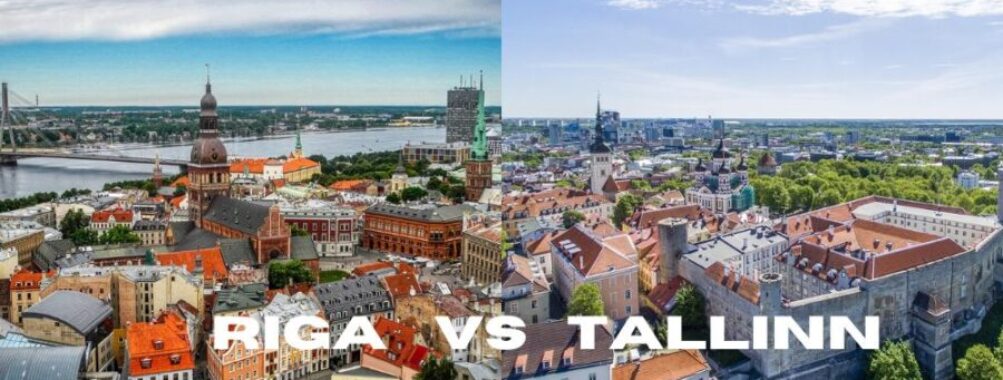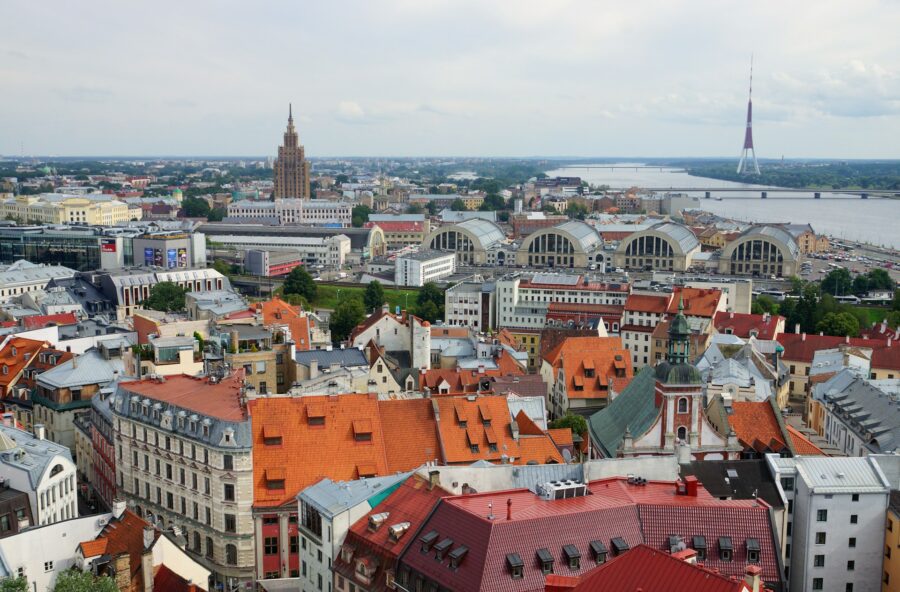
Riga vs Tallinn: Baltic Gems Compared – Which City Wins in 2025?
Planning a trip to the Baltic region often leads travelers to choose between two captivating capitals: Riga and Tallinn. These enchanting cities each offer a unique blend of medieval charm and modern culture that makes picking between them quite tricky.
Most travelers prefer Tallinn for a first visit to the Baltics. The city has a compact, well-preserved medieval Old Town and a slightly more polished tourist infrastructure. However, it does come with roughly 15-20% higher prices than Riga. While Estonia‘s capital feels like stepping into a fairy tale, Latvia‘s Riga impresses with its grand Art Nouveau architecture and a more local, authentic atmosphere.
Both cities reward visitors with fascinating histories, distinctive cuisines, and rich cultural scenes. Riga spans a larger area and houses about 630,000 residents, making it feel more like a proper city compared to Tallinn’s intimate historic core. The choice often comes down to whether you prefer Tallinn’s storybook medieval setting or Riga’s more metropolitan vibe.
Table of Contents
- Geographical Context and Accessibility
- Comparing Locations
- Travel Connections
- Historical Insights
- Medieval Charm and History
- UNESCO World Heritage Sites
- Cultural Tapestry and Architecture
- Signature Architectural Highlights
- Art and Museums
- Urban Experience
- Marketplaces and Shopping
- Recreational Activities
- Gastronomic Delight
- Culinary Scene and Cuisine
- Bars and Craft Beer Culture
- Annual Events and Festivities
- Christmas Markets and Holiday Celebrations
- Cultural Festivals and Events
- Outdoor and Family Activities
- Natural Landscapes and Parks
- Family-Friendly Attractions
- Accommodation and Livability
- Staying in Riga and Tallinn
- Walkability and Public Spaces
- Frequently Asked Questions
- What distinguishes the Christmas markets in Riga from those in Tallinn?
- In terms of cost of living, how do Riga and Tallinn compare?
- What unique experiences do Riga and Tallinn offer to a first-time visitor to the Baltic region?
- How do nightlife and cultural offerings in Tallinn contrast with those in Riga?
- Can you highlight the historical differences that visitors should be aware of when exploring Riga and Tallinn?
- Which city, Riga or Tallinn, is generally recommended for a longer stay, considering attractions and activities available?
- Book Your Dream Experience
- More Travel Guides
Geographical Context and Accessibility
Both Baltic capitals sit in strategic locations along major trade routes, making them important regional transportation hubs with strong connections to neighboring countries.
Comparing Locations

Riga sits near the mouth of the Daugava River in central Latvia. Its position makes it a natural gateway between Eastern and Western Europe. The city spreads across flat terrain that extends to the Gulf of Riga, part of the Baltic Sea.
Tallinn hugs Estonia’s northern coast along the Gulf of Finland. The medieval Old Town rises on a limestone cliff overlooking the harbor, while modern districts stretch inland across gently rolling hills.
Both cities enjoy coastal locations that shaped their growth as trade centers. Their proximity to the Baltic Sea gives them mild winters compared to inland areas, though Tallinn tends to be a bit colder due to its more northern position.
Travel Connections

Getting between these Baltic capitals is straightforward. Regular buses run the 4-hour route multiple times daily. Express trains link the cities too, though the journey takes longer than the bus.
Both cities have modern airports with good European connections. You can find affordable flights to major hubs through multiple carriers. Search flights and hotels to compare options.
Ferry services connect Tallinn to Helsinki and Stockholm across the Baltic Sea. Riga’s port handles mostly cargo traffic but offers some passenger routes to Sweden and Germany.
Local public transit in both cities is efficient and budget-friendly. Buses, trams, and trolleybuses cover all major areas. Tallinn even offers free public transport to residents.
Historical Insights
Both Riga and Tallinn stand as living museums of Baltic history, with centuries-old architecture and cultural treasures that tell fascinating stories of merchants, medieval guilds, and changing empires. The cities showcase remarkable preservation of their medieval quarters while honoring more recent historical events.
Medieval Charm and History

Tallinn’s Old Town sits perched atop limestone cliffs, crowned by Toompea Hill where noble families once lived. Its winding cobblestone streets and defensive walls transport visitors back to the 13th century. The well-preserved merchant houses and guild halls reflect the city’s importance in the Hanseatic League.
Riga’s medieval core features distinctive spires and guild houses from its own Hanseatic past. The iconic House of the Blackheads dates to 1334, though the current building is a faithful 1990s reconstruction. The city’s Freedom Monument stands as a powerful symbol of Latvia’s independence struggles.
UNESCO World Heritage Sites

Tallinn’s Old Town earned UNESCO status in 1997, recognized for having one of Europe’s best-preserved medieval trading cities. Its town wall and 26 watchtowers paint a picture of life in a fortified medieval city.
Riga’s historic center gained UNESCO recognition for its art nouveau architecture. Over 800 buildings showcase this distinctive style, especially along Alberta Street. The Old Town blends medieval architecture with later periods, including wooden buildings in the city center.
The two cities preserve different aspects of Baltic heritage. Tallinn emphasizes its medieval fortress character, while Riga displays a broader architectural timeline spanning Gothic to art nouveau.
Cultural Tapestry and Architecture
Both capitals showcase distinct architectural heritage that tells unique stories of their past. Tallinn keeps its medieval charm alive through preserved Gothic structures, while Riga stands out with its world-famous Art Nouveau designs.
Signature Architectural Highlights

Tallinn’s Old Town feels like stepping into a fairy tale with its Gothic masterpieces. The stunning Toompea Castle sits high on a limestone hill, serving as Estonia’s parliament building today. The Alexander Nevsky Cathedral adds a dramatic touch with its black domes and intricate Russian Orthodox design.
Riga’s architecture tells a different story. The city holds the world’s largest collection of Art Nouveau buildings, making up about one-third of its center. The House of the Blackheads stands as a prime example of Gothic architecture with its red brick facade and Dutch Renaissance elements.
Art and Museums

Tallinn’s art scene centers around two major attractions. The Kumu Art Museum shows off Estonian art from the 1750s to today in its modern building. Kadriorg Palace, built by Peter the Great, houses foreign art collections in a stunning Baroque setting.
Riga’s museums focus on local history and natural sciences. The Latvian Museum of Natural History offers fun exhibits for families. The city also features smaller galleries scattered throughout its Art Nouveau district, many housed in historic buildings.
The museums in both cities keep shorter hours during winter months. Many offer free entry on specific days each month.
Urban Experience
Both Riga and Tallinn mix their historic charm with modern urban life to create distinct city atmospheres that give visitors plenty to explore and enjoy.
Marketplaces and Shopping

The Central Market in Riga stands out as one of Europe’s biggest markets. Set inside converted Zeppelin hangars, it buzzes with local vendors selling fresh produce, meats, and Baltic specialties. The market gives visitors a real taste of daily Latvian life.
Shopping in Tallinn centers around its creative hubs. The Telliskivi Creative City turns old factory buildings into a hip district filled with indie shops, art galleries, and design stores. Local Estonian crafts and handmade items are easy to find in the Old Town’s small boutiques.
Recreational Activities

Riga’s art nouveau district gives walkers plenty to admire. The streets around Alberta Street showcase some of Europe’s finest examples of this architectural style. Visitors can spot detailed facades with sculptures of mythical creatures and elaborate floral designs.
Parks dot both cities and offer peaceful breaks. Riga’s Bastejkalna Park features walking paths along the city canal. Tallinn’s Kadriorg Park surrounds a grand palace and includes peaceful gardens perfect for afternoon strolls.
The cities offer different ways to see their sights. Riga Castle tours let visitors explore Latvia’s presidential home. In Tallinn, the medieval walls provide walking routes with great views of red-tiled roofs below.
Gastronomic Delight
Both Baltic capitals offer unique culinary experiences, from traditional dishes to modern interpretations, plus thriving craft beer scenes that showcase local brewing talents.
Culinary Scene and Cuisine

Tallinn’s medieval-inspired restaurants serve hearty Estonian classics like mulgipuder (barley porridge) and verivorst (blood sausage). The Tallinn Food Market in the Rotermann Quarter brings together local vendors and modern food stalls under one roof.
Riga’s food scene shines with Latvian specialties like rasol (potato salad) and pelmeni (dumplings). The Central Market, housed in converted zeppelin hangars, offers fresh local produce and traditional treats.
Both cities embrace Nordic-inspired fine dining. Tallinn’s restaurants focus on foraged ingredients and seasonal dishes. Riga’s chefs blend traditional recipes with modern techniques.
Bars and Craft Beer Culture

Tallinn’s craft beer scene centers around the Kalamaja district, where local breweries like Põhjala create unique Baltic-inspired brews. Small tap rooms dot the cobblestone streets, offering tasting flights of Estonian beers.
Riga’s beer culture dates back centuries. The city’s craft brewers experiment with local ingredients like birch sap and regional herbs. Popular spots include the Labietis brewery and various beer cellars in the Old Town.
Street-side bars in both cities serve regional classics like Vana Tallinn liqueur and Riga Black Balsam. Many venues offer beer-and-food pairing menus featuring local specialties.
Annual Events and Festivities
Both Riga and Tallinn light up throughout the year with vibrant festivals, cultural celebrations, and seasonal events that showcase their unique Baltic heritage and modern entertainment scenes.
Christmas Markets and Holiday Celebrations

The medieval squares in both cities transform into magical winter wonderlands during December. Tallinn’s Christmas Market in Town Hall Square dates back to 1441, making it one of Europe’s oldest. Visitors gather around the massive Christmas tree, shop at wooden stalls, and sip mulled wine.
Riga’s Christmas markets spread across several locations, with the main one in Dome Square. Local crafts, traditional foods like piparkūkas (gingerbread), and festive concerts create a cozy atmosphere. The city claims to be the birthplace of the decorated Christmas tree tradition.
Cultural Festivals and Events

Tallinn shines in 2025 as the European Capital of Sport, hosting year-round athletic events and competitions. The city’s Old Town Days in June celebrate medieval culture with street performances, craft markets, and historical reenactments.
Riga hosts major music festivals throughout summer. The city comes alive during its birthday celebration in August with concerts, parades, and fireworks over the Daugava River.
Both cities feature open-air concerts, food festivals, and folk celebrations during the warmer months. These events attract a mix of locals and tourists, from families seeking cultural experiences to young backpackers drawn to the music scene.
The cities’ festivals blend traditional Baltic customs with modern entertainment, creating unique experiences that showcase their living heritage.
Outdoor and Family Activities
Both cities offer green spaces and activities that kids and nature lovers will enjoy. The mix of historic charm and modern attractions makes these destinations perfect for families seeking both educational and fun experiences.
Natural Landscapes and Parks

Tallinn’s green spaces blend with its medieval charm. Kadriorg Park stands out with its royal gardens and peaceful walking paths. The park surrounds the stunning Kadriorg Palace, making it a great spot for picnics and photos.
Riga’s Bastejkalna Park sits right next to the Old Town. Its winding paths, canals, and sculptures create a peaceful retreat from city life. The park is perfect for morning walks or afternoon breaks between sightseeing.
Just outside Riga, Jurmala beach attracts families with its soft sand and shallow waters. The beach town offers 33 kilometers of coastline for swimming and sandcastle building.
Family-Friendly Attractions

Tallinn’s Old Town is like a fairy tale come to life. Kids love walking the medieval walls and climbing the watch towers. The narrow cobblestone streets and hidden passages feel like stepping into a storybook.
The Estonian Open Air Museum near Tallinn shows how people lived in the past. Children can explore old farmhouses and try traditional crafts.
Riga’s parks have modern playgrounds scattered throughout the city. The Riga Zoo keeps kids entertained with over 400 species of animals.
Both cities offer boat trips that give families a different view of the historic centers. These short cruises are perfect for tired legs after walking tours.
Accommodation and Livability
Both cities offer unique living experiences with distinct accommodation options and outdoor spaces that shape daily life. The cost of staying in these Baltic capitals varies notably between tourist areas and local neighborhoods.
Staying in Riga and Tallinn

Tallinn’s hotel accommodations tend to be pricier than Riga’s, with rates about 15-20% higher. This price difference is most noticeable in the Old Town areas.
Riga provides more budget-friendly options for backpackers and families. Many affordable hotels and hostels are located just outside the city center.
Couples often prefer Tallinn’s boutique hotels, which blend medieval charm with modern comforts. The city excels at providing romantic settings, especially in restored historical buildings.
Walkability and Public Spaces

Riga covers 117 square miles, spreading across a larger area. Its size means more diverse neighborhoods to explore but longer distances to travel.
Tallinn’s compact Old Town makes it perfect for walking tours. Most tourist attractions sit within a 15-minute walk of each other.
Both cities maintain excellent public transport networks. Trams, buses, and trolleybuses run frequently and connect all major areas.
Green spaces dot both cities, but Riga edges ahead with more parks and public squares. These areas become social hubs during summer months.
Families appreciate Tallinn’s pedestrian-friendly zones and car-free areas. The city has invested heavily in making streets safe for children and elderly residents.
Frequently Asked Questions
Both Riga and Tallinn offer distinct experiences shaped by their rich histories, cultural scenes, and modern developments. Each city brings something special to Baltic tourism, from medieval architecture to vibrant food scenes.
What distinguishes the Christmas markets in Riga from those in Tallinn?
Riga’s Christmas market centers around Dome Square, featuring traditional Latvian crafts and mulled wine called “Karstvīns.” Local vendors sell handmade wool mittens and amber jewelry.
Tallinn’s market takes place in Town Hall Square, surrounded by medieval buildings. Estonian handicrafts, black pudding, and “Glögi” (spiced wine) make this market special. The city claims to be the first place to display a public Christmas tree, dating back to 1441.
In terms of cost of living, how do Riga and Tallinn compare?
Tallinn tends to be more expensive, especially in tourist areas and restaurants. Housing costs are about 15-20% higher than in Riga.
Riga offers better value for dining out and accommodation. Public transport is cheaper in Riga, with a single ticket costing less than in Tallinn.
What unique experiences do Riga and Tallinn offer to a first-time visitor to the Baltic region?
Riga stands out for its Art Nouveau architecture, especially along Alberta Street. The Central Market, housed in old zeppelin hangars, lets visitors sample local foods and meet locals.
Tallinn’s medieval Old Town feels like stepping into a fairy tale. Visitors can walk the ancient city walls and climb St. Olaf’s Church tower for amazing views.
How do nightlife and cultural offerings in Tallinn contrast with those in Riga?
Riga has a more diverse nightlife scene spread across different districts. The city offers many live music venues, from jazz clubs to electronic music spots.
Tallinn’s nightlife concentrates in the Old Town and Teliskivi Creative City. The city excels in electronic music events and craft beer bars.
Can you highlight the historical differences that visitors should be aware of when exploring Riga and Tallinn?
Riga shows strong German and Swedish influences in its architecture and culture. The city played a key role as a major trading port in the Hanseatic League.
Tallinn preserved more of its medieval character due to its location and historical circumstances. The Estonian capital maintains strong Nordic influences from centuries of Danish and Swedish rule.
Which city, Riga or Tallinn, is generally recommended for a longer stay, considering attractions and activities available?
Riga works better for extended stays due to its larger size and more varied neighborhoods to explore. The city offers more day trip options to nearby beaches and national parks.
Riga also provides better connections to other European destinations through its larger airport and bus terminal.



